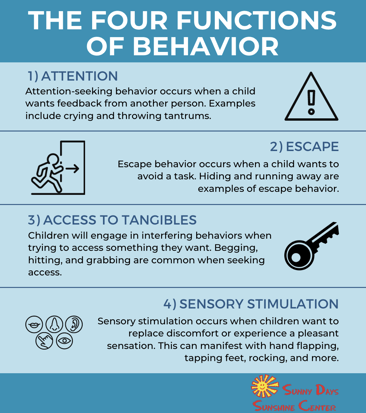The Four Functions of Behavior: Understanding Your Child's Actions

All behaviors occur for a reason. To understand the purpose for a child's behaviors, as well as to encourage positive actions and discourage problem habits, we first must understand the four functions of behavior.
In this post, we overview each of the four functions of behavior, as well as the ABCs of behavior (aka components of behavior).
What are the Four Functions of Behavior?
The predominant four functions of behavior are attention, escape, access, and sensory needs. These four functions allow us to understand and categorize someone’s actions, as well as determine why behaviors occur.
All actions can be attributed to one of these four functions of behavior.
- Attention
The first function of behavior is attention. Attention-seeking behavior occurs when someone desires feedback or a responsefrom another person. Crying and throwing tantrums are great examples of childhood attention-seeking habits. To dissuade attention-seeking behavior, the key is to ignore problem behaviors, as this demonstrates that negative behaviors won't be rewarded. Attention seekers may settle for any type of attention, whether positive or negative.
Examples of attention include:
- Praise, such as cheering and words of affirmation
- Scolding, saying no, or moving a child’s hand away
- Redirecting your attention to your child
- Showing disappointment or frustration with facial expressions and body language
- Escape
Escape behaviors typically occur when a learner wants to avoid or “escape” doing something. This is common in ABA therapy session instructional periods.
For example, if a child does not want to complete a puzzle or read a book, she or he may run away from the therapist to avoid the instructional activity. Token systems can be effective in treating escape behaviors since this structure allows for designated time for both play and instruction.
- Access To Tangibles
Access to tangibles is somewhat self-explanatory, but it is also very important. Children may engage in certain behaviors because they are looking to gain access to something. For example, wanting a cookie. That cookie is a strong reinforcement for the child, so he or she will engage in interfering behaviors to get the cookie. While it is acceptable to reinforce your child’s positive behaviors with tangibles, remember that this is a function of behavior. Keep in mind that access-related behaviors occur surrounding items the child can’t access independently.
When trying to access a tangible reward, a child may:
- Beg
- Scream, cry, or throw a tantrum
- Hit or bite
- Grab the item away from someone else
-
Sensory Stimulation
Sensory stimulation (also known as sensory needs) is the final function of behavior. Sensory stimulation occurs when children want to experience a pleasant sensation or replace discomfort. Children may also seek stimulation to sensitize or desensitize, depending on their sensory needs.
Sensory stimulation can manifest itself in several ways, such as:
- Jumping
- Skipping
- Hand-flapping
- Tapping feet
- Rocking back and forth

The ABCs of Behavior
Each behavior or action consists of three parts: the antecedent, the behavior, and the consequence.
Antecedents are events (internal or external) which trigger behaviors. An example of an external behavior could be a teacher instructing a child to write a paragraph. An internal behavior could be a child feeling hungry.
Behaviors are anything a person does. External/observable behaviors are those that someone other than the person executing the behavior can see. Internal/non-observable behaviors are those that others cannot see, such as a person’s thoughts.
Consequences are what occurs directly following a behavior. Handing a child a cookie after she points at the cookie jar is an example of a consequence. Repeated consequences reinforce behaviors.
Knowing the functions and ABCs of behavior will help you identify and understand both desired and problematic habits in your child. If you are concerned about your child’s behavior, please reach out to us.
Further reading:
Six Helpful Tips to Managing Your Child's Unwanted Behaviors
Photo by Kelly Sikkema on Unsplash
David DeFranco
David DeFranco is a recent graduate from Seton Hall University. He earned his B.A. in Social and Behavioral Sciences in May of 2020 and is currently enrolled in Seton Hall’s M.A. in ABA program. He is an RBT for the Sunshine Center and is pursuing his BCBA credential.
